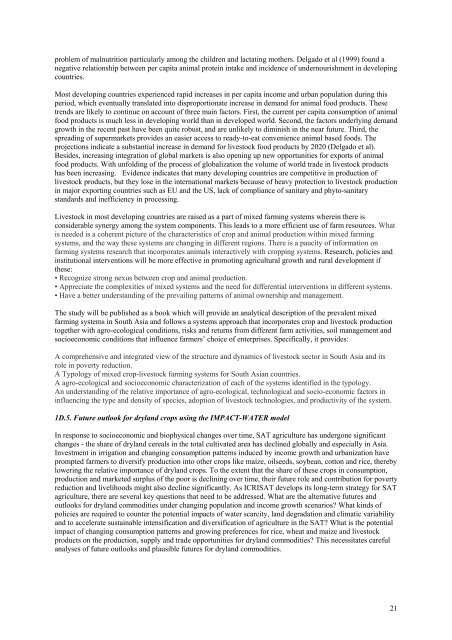ICRISAT Archival Report 2006 - The seedlings of success in the ...
ICRISAT Archival Report 2006 - The seedlings of success in the ...
ICRISAT Archival Report 2006 - The seedlings of success in the ...
You also want an ePaper? Increase the reach of your titles
YUMPU automatically turns print PDFs into web optimized ePapers that Google loves.
problem <strong>of</strong> malnutrition particularly among <strong>the</strong> children and lactat<strong>in</strong>g mo<strong>the</strong>rs. Delgado et al (1999) found a<br />
negative relationship between per capita animal prote<strong>in</strong> <strong>in</strong>take and <strong>in</strong>cidence <strong>of</strong> undernourishment <strong>in</strong> develop<strong>in</strong>g<br />
countries.<br />
Most develop<strong>in</strong>g countries experienced rapid <strong>in</strong>creases <strong>in</strong> per capita <strong>in</strong>come and urban population dur<strong>in</strong>g this<br />
period, which eventually translated <strong>in</strong>to disproportionate <strong>in</strong>crease <strong>in</strong> demand for animal food products. <strong>The</strong>se<br />
trends are likely to cont<strong>in</strong>ue on account <strong>of</strong> three ma<strong>in</strong> factors. First, <strong>the</strong> current per capita consumption <strong>of</strong> animal<br />
food products is much less <strong>in</strong> develop<strong>in</strong>g world than <strong>in</strong> developed world. Second, <strong>the</strong> factors underly<strong>in</strong>g demand<br />
growth <strong>in</strong> <strong>the</strong> recent past have been quite robust, and are unlikely to dim<strong>in</strong>ish <strong>in</strong> <strong>the</strong> near future. Third, <strong>the</strong><br />
spread<strong>in</strong>g <strong>of</strong> supermarkets provides an easier access to ready-to-eat convenience animal based foods. <strong>The</strong><br />
projections <strong>in</strong>dicate a substantial <strong>in</strong>crease <strong>in</strong> demand for livestock food products by 2020 (Delgado et al).<br />
Besides, <strong>in</strong>creas<strong>in</strong>g <strong>in</strong>tegration <strong>of</strong> global markets is also open<strong>in</strong>g up new opportunities for exports <strong>of</strong> animal<br />
food products. With unfold<strong>in</strong>g <strong>of</strong> <strong>the</strong> process <strong>of</strong> globalization <strong>the</strong> volume <strong>of</strong> world trade <strong>in</strong> livestock products<br />
has been <strong>in</strong>creas<strong>in</strong>g. Evidence <strong>in</strong>dicates that many develop<strong>in</strong>g countries are competitive <strong>in</strong> production <strong>of</strong><br />
livestock products, but <strong>the</strong>y lose <strong>in</strong> <strong>the</strong> <strong>in</strong>ternational markets because <strong>of</strong> heavy protection to livestock production<br />
<strong>in</strong> major export<strong>in</strong>g countries such as EU and <strong>the</strong> US, lack <strong>of</strong> compliance <strong>of</strong> sanitary and phyto-sanitary<br />
standards and <strong>in</strong>efficiency <strong>in</strong> process<strong>in</strong>g.<br />
Livestock <strong>in</strong> most develop<strong>in</strong>g countries are raised as a part <strong>of</strong> mixed farm<strong>in</strong>g systems where<strong>in</strong> <strong>the</strong>re is<br />
considerable synergy among <strong>the</strong> system components. This leads to a more efficient use <strong>of</strong> farm resources. What<br />
is needed is a coherent picture <strong>of</strong> <strong>the</strong> characteristics <strong>of</strong> crop and animal production with<strong>in</strong> mixed farm<strong>in</strong>g<br />
systems, and <strong>the</strong> way <strong>the</strong>se systems are chang<strong>in</strong>g <strong>in</strong> different regions. <strong>The</strong>re is a paucity <strong>of</strong> <strong>in</strong>formation on<br />
farm<strong>in</strong>g systems research that <strong>in</strong>corporates animals <strong>in</strong>teractively with cropp<strong>in</strong>g systems. Research, policies and<br />
<strong>in</strong>stitutional <strong>in</strong>terventions will be more effective <strong>in</strong> promot<strong>in</strong>g agricultural growth and rural development if<br />
<strong>the</strong>se:<br />
• Recognize strong nexus between crop and animal production.<br />
• Appreciate <strong>the</strong> complexities <strong>of</strong> mixed systems and <strong>the</strong> need for differential <strong>in</strong>terventions <strong>in</strong> different systems.<br />
• Have a better understand<strong>in</strong>g <strong>of</strong> <strong>the</strong> prevail<strong>in</strong>g patterns <strong>of</strong> animal ownership and management.<br />
<strong>The</strong> study will be published as a book which will provide an analytical description <strong>of</strong> <strong>the</strong> prevalent mixed<br />
farm<strong>in</strong>g systems <strong>in</strong> South Asia and follows a systems approach that <strong>in</strong>corporates crop and livestock production<br />
toge<strong>the</strong>r with agro-ecological conditions, risks and returns from different farm activities, soil management and<br />
socioeconomic conditions that <strong>in</strong>fluence farmers’ choice <strong>of</strong> enterprises. Specifically, it provides:<br />
A comprehensive and <strong>in</strong>tegrated view <strong>of</strong> <strong>the</strong> structure and dynamics <strong>of</strong> livestock sector <strong>in</strong> South Asia and its<br />
role <strong>in</strong> poverty reduction.<br />
A Typology <strong>of</strong> mixed crop-livestock farm<strong>in</strong>g systems for South Asian countries.<br />
A agro-ecological and socioeconomic characterization <strong>of</strong> each <strong>of</strong> <strong>the</strong> systems identified <strong>in</strong> <strong>the</strong> typology.<br />
An understand<strong>in</strong>g <strong>of</strong> <strong>the</strong> relative importance <strong>of</strong> agro-ecological, technological and socio-economic factors <strong>in</strong><br />
<strong>in</strong>fluenc<strong>in</strong>g <strong>the</strong> type and density <strong>of</strong> species, adoption <strong>of</strong> livestock technologies, and productivity <strong>of</strong> <strong>the</strong> system.<br />
1D.5. Future outlook for dryland crops us<strong>in</strong>g <strong>the</strong> IMPACT-WATER model<br />
In response to socioeconomic and biophysical changes over time, SAT agriculture has undergone significant<br />
changes - <strong>the</strong> share <strong>of</strong> dryland cereals <strong>in</strong> <strong>the</strong> total cultivated area has decl<strong>in</strong>ed globally and especially <strong>in</strong> Asia.<br />
Investment <strong>in</strong> irrigation and chang<strong>in</strong>g consumption patterns <strong>in</strong>duced by <strong>in</strong>come growth and urbanization have<br />
prompted farmers to diversify production <strong>in</strong>to o<strong>the</strong>r crops like maize, oilseeds, soybean, cotton and rice, <strong>the</strong>reby<br />
lower<strong>in</strong>g <strong>the</strong> relative importance <strong>of</strong> dryland crops. To <strong>the</strong> extent that <strong>the</strong> share <strong>of</strong> <strong>the</strong>se crops <strong>in</strong> consumption,<br />
production and marketed surplus <strong>of</strong> <strong>the</strong> poor is decl<strong>in</strong><strong>in</strong>g over time, <strong>the</strong>ir future role and contribution for poverty<br />
reduction and livelihoods might also decl<strong>in</strong>e significantly. As <strong>ICRISAT</strong> develops its long-term strategy for SAT<br />
agriculture, <strong>the</strong>re are several key questions that need to be addressed. What are <strong>the</strong> alternative futures and<br />
outlooks for dryland commodities under chang<strong>in</strong>g population and <strong>in</strong>come growth scenarios? What k<strong>in</strong>ds <strong>of</strong><br />
policies are required to counter <strong>the</strong> potential impacts <strong>of</strong> water scarcity, land degradation and climatic variability<br />
and to accelerate susta<strong>in</strong>able <strong>in</strong>tensification and diversification <strong>of</strong> agriculture <strong>in</strong> <strong>the</strong> SAT? What is <strong>the</strong> potential<br />
impact <strong>of</strong> chang<strong>in</strong>g consumption patterns and grow<strong>in</strong>g preferences for rice, wheat and maize and livestock<br />
products on <strong>the</strong> production, supply and trade opportunities for dryland commodities? This necessitates careful<br />
analyses <strong>of</strong> future outlooks and plausible futures for dryland commodities.<br />
21

















